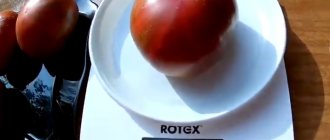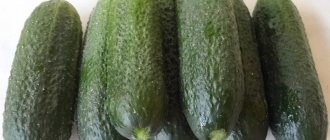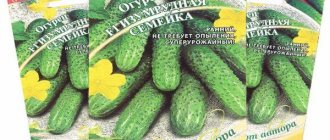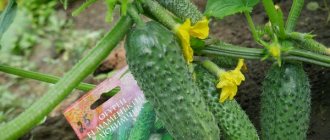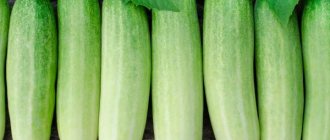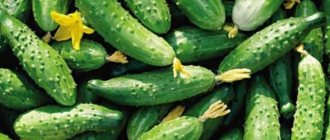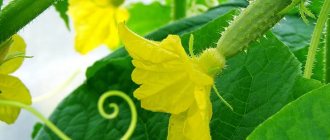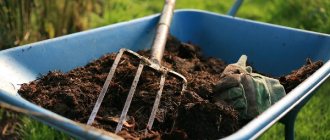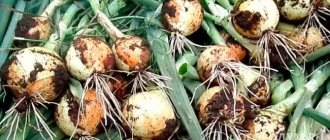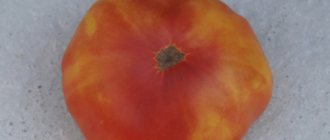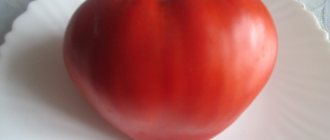Characteristics and description of the variety
The variety was obtained by Russian breeders in Moscow in 2007. Zyatek F1 cucumbers can be grown not only in open ground, but also in a greenhouse. An important feature of the variety is that a bountiful harvest of vegetables can be obtained even in cool and rainy summer conditions.
Did you know? The surface of young cucumbers is covered with small spines.
Fruits need them in order to better evaporate excess moisture from the pulp and peel. Characteristics of Zyatek F1 cucumbers:
- The bush is medium-sized, has many lateral weaving shoots.
- The leaves are medium sized, green in color.
- The root system is branched but fragile. The roots are located close to the surface of the earth.
- The variety is early ripening, cucumbers ripen 42-48 days after the first shoots appear. The bush bears fruit until the end of September.
- Flowering type: female. Does not require pollination by bees.
- The ovaries are formed in bunches; up to 50 bunches can form on one plant.
- The fruits are small, their length is 10–12 cm, diameter - 3.5 cm. The weight of one vegetable is about 100 g.
- The vegetables are covered with a thin dark green skin. Small white pimples are clearly visible on its surface.
- The pulp of cucumbers is juicy and crunchy and contains small seeds.
- The fruits have a sweetish taste and pleasant aroma. When a vegetable overripes, its taste does not deteriorate.
- The yield per 1 m² is 7–13 kg.
Description of cucumber Zyatek F1
The hybrid cucumber variety Zyatek F1 belongs to the family of parthenocarpic plants. This means that this type of cucumber does not require the help of pollinating insects to pollinate flowers. In principle, varieties such as Zyatek F1 were bred by breeders for cultivation in greenhouse conditions. These are popular vegetables among gardeners.
Some gardeners believe that cucumbers that have been pollinated by insects are superior in taste to parthenocarpic plants. Every opinion has the right to life, as they say. The advantages of an early ripening variety are obvious.
Let's take a closer look at the main characteristics of the Zyatek F1 variety.
- It is preferable to grow the variety in greenhouse conditions, although cucumbers can also grow normally in open ground.
- In terms of ripening time, the crop is classified as a mid-season vegetable. For cucumbers of this variety, this process takes 45-47 days.
- The stem of the Zyatek F1 cucumber can grow very long, so the variety belongs to indeterminate plants.
- The type of flowering in the variety is often female.
- Like all hybrids, these cucumbers do not require insects for pollination to form an ovary.
- Young cucumbers are tied in the deciduous part of the stem in a bunch type. Up to 5-8 vegetables can ripen in one axillary inflorescence. It is advisable to collect the fruits at the gherkin stage so that more new ovaries are formed.
- The variety is characterized by high productivity. If agricultural technology was used correctly, then one stem can produce up to 50 cucumbers. In one summer season you can collect up to 5-7 kg from a bush.
- The culture is disease resistant. The root system is not often affected by gray rot.
- Special care for cucumbers of this variety is not required.
Popular: Secrets of caring for and growing high beet yields
How does Zyatka F1 bloom?
The plant blooms according to the female type. This means that each flower produces an ovary; there are no barren flowers on the variety. In one axillary node, 3-5 ovaries are formed, and on the side shoots - up to 8 pieces.
Fruiting is long, it does not end until the end of the growing season. Each plant can produce a cucumber harvest of up to 5-7 kg, and one square meter of plantings can produce up to 13 kg. The stem of the cucumber variety Zyatek F1 is branched, the leafy part is medium in size.
Caring for this crop is not difficult. The main thing is to form side shoots to get more cucumbers. Water, loosen the soil, remove weeds and apply fertilizer. The Zyatek F1 variety is able to recover from stress and is adapted to unfavorable weather.
You can enjoy the first young gherkins 42-43 days after planting the seedlings. Cucumbers are removed as they ripen, but the recommended size is up to 7-9 cm. The fruits are tasty, the peel is not bitter, the seed box is small and tender. The variety is suitable for fresh salads, pickles and pickles.
Green gherkins look similar to a cylinder. The color of the fruit is rich green. On the surface of the cucumbers there are blurry short light stripes, in some places the tubercles are covered with a white edge, there are no thorns.
It is recommended to remove young greens regularly. Cucumbers are not overgrown, but if they are not picked in time, they will become full and look like barrels. With timely harvesting, the fruits are able to retain their full presentation for a long time. The stem continues to form new ovaries.
The hybrid plant is resistant to many problems, for example, common powdery mildew, gray root rot, and downy mildew. When purchasing seeds of the Zyatek F1 variety, focus on well-known manufacturers whose products have been tested for years. Although a pack of seeds is expensive, the result will be worth it in the end.
Advantages and disadvantages
Zyatek F1 is a young variety, but despite this, it has already gained popularity in many regions of Russia.
- These cucumbers are chosen for cultivation due to their many positive qualities:
- high productivity;
- good taste characteristics;
- early ripening and long fruiting;
- ease of care;
- immunity to diseases;
- high seed germination rate;
- resistance to adverse climatic conditions;
- possibility of growing in open ground or in a greenhouse;
- the possibility of using small cucumbers for canning for the winter;
- good transportability of vegetables.
- The disadvantages of the plant include:
- roots that are too fragile and located close to the soil surface;
- the need for a separate container for each sprout when growing seedlings;
- sensitivity to watering with cold water;
- high price of seeds.
Advantages and disadvantages
The hybrid form “Zyatek f1” is perfectly adapted to cultivation in homestead farms in our country and has the following characteristics:
- excellent taste and appearance of the fruit;
- versatility of using cucumbers;
- the possibility of collecting not overgrown greens for pickles or gherkins;
- high overall yield;
- adaptability to many adverse weather factors;
- good seedling survival rate and high seed germination;
- the ability to transport crops over long distances;
- unpretentiousness in terms of care;
- good resistance to cladosporiosis, VOM, LMR and NMR.
The average yield of one plant with proper care is at least 7 kg. The marketable yield is about 13.2 kg per square meter. The hybrid form successfully combines the excellent taste of crispy, aromatic fruits and the versatility of their use.
Optimal planting dates
When growing cucumbers from seedlings, the seeds can be sown in a container with soil at the end of April.
Important! In pursuit of an early harvest, it is not recommended to start growing seedlings too early, as in this case the seedlings will be overgrown and will not tolerate transplantation well.
When planting cucumber seeds of this variety in open soil, it is necessary to exclude the possibility of night frosts, as they can destroy the seeds. It is necessary to sow planting material into the soil only after the night air temperature does not fall below +12°C. Usually cucumber seeds are sown in open ground at the end of May.
Agricultural technology of the Zyatek F1 variety
- We sow the seeds. If you plan to plant cucumbers in seedlings, then the seeds are sown in prepared peat pots in April. The root system of the variety is very delicate, so they are planted directly in pots in a permanent place of growth.
- We plant in open ground. As soon as the spring night frosts have passed, the temperature stabilizes, young seedlings are planted in the beds. During this period, you can sow seeds directly into open ground. The soil for cucumbers should be sandy loam and enriched with useful microelements.
- We water the cucumbers regularly. This crop is moisture-loving, so the plant requires normal watering, preferably in the evening. Cucumbers may respond to excess moisture by rotting the roots, as a result of which the bush may die. For irrigation, it is better to use settled warm water.
- We tie the long lashes of the plant to the support. To grow cucumbers, trellises are used, constructed from poles to which ropes are attached. As it develops, the stem will climb along them, clinging with its tendrils.
- We apply fertilizing in a timely manner. To increase the yield of a variety, it is necessary to regularly apply fertilizer to the bushes, preferably in liquid form. At the initial stage, young seedlings need mineral types of fertilizers, and later organic matter can be added. For this purpose, diluted bird droppings and mullein are used. Over the entire season, fertilizing is applied 4-5 times, but no more. An excess of microelements can lead to an increase in leaf mass, which will be at the expense of the formation of ovaries.
Popular: Decorating gardens with ornamental cabbage after planting
Currently reading:
- Description of 12 types of late cabbage varieties for planting
- Description of the best tomato varieties for planting in 2021
- All the benefits of mulching the soil for high yields
- Confidentiality
Share the news on social networks
About the author: Victoria Semyonovna Nakhodkina
Leading researcher at the laboratory of vegetable and berry crops, Yakut Scientific Research Institute of Agriculture, Siberian Branch of the Russian Academy of Agricultural Sciences, Republic of Sakha (Yakutia).
Planting and growing cucumbers
Cucumbers of the Zyatek F1 variety are grown from seeds. For planting, you can only use purchased planting material, since the variety is a hybrid and seeds collected independently from last year’s harvest do not transfer their characteristics to the plants grown from them. Cultivation can be carried out by seedlings and without seedlings. Each has its own characteristics, so we will consider them separately.
Seedling method
The advantage of this method is the possibility of obtaining an early harvest. But the fragile roots of seedlings require careful handling when transplanting seedlings into open ground.
Important! By the time the seedlings are transplanted into open ground, they should have 2 to 4 green leaves.
A detailed description of the process of sowing seeds for growing seedlings:
- Prepare separate glasses for each seed. You cannot plant seeds in one large container, since in this case, when transplanting seedlings into open ground, you can accidentally damage their roots.
- Take the required amount of soil from the area where the plant sprouts will be planted in the future. Mix the soil with peat, humus, ash and sand.
- Divide the mixture into individual glasses so that only a third of the container is filled. Lightly water the soil with warm water.
- Make a 2–3 cm depression in the soil and place 1 seed in it. Sprinkle with earth.
- Place the glasses with seeds in a bright place and keep them at a temperature of +25...+30°C until shoots appear.
- Water the seeds every 1–2 days with settled water at room temperature.
- After a couple of green leaves appear on the young seedling, gradually add soil to the pot as the sprout grows.
- A week before the planned transplantation of sprouts into open ground, begin hardening the seedlings. To do this, containers with seedlings are briefly taken out onto the street or balcony. The time the seedlings spend in the open air should not exceed 20–30 minutes at first, then it is gradually increased.
- At the end of May or beginning of July, plant the seedlings in open ground. Seedlings must be carefully removed from individual containers along with a lump of earth and placed in holes on the site. Then carefully sprinkle the roots with soil.
Video: Growing cucumber seedlings
In a seedless way
In order for Zyatek F1 cucumber bushes to produce a bountiful harvest of vegetables, you need to plant them in the right area.
Tips for choosing a landing site:
- the plot must have sufficient area, because cucumbers require a lot of free space to grow. The number of plants per 1 m² should not exceed 4–5 pieces;
- the soil on the site must have a nutritious composition and be light to allow air and water to pass through;
- To prevent the plants from wilting under the hot rays of the sun, it is better to place the place for cucumbers in partial shade. You can choose areas that are brightly illuminated by the sun only in the morning or evening.
In order for the planted cucumber seeds to germinate, you need to prepare the soil in the selected area for planting in advance. Step-by-step algorithm for preparing beds:
- In the fall, add fertilizer to the soil to saturate it with nutrients. Use peat, manure, wood ash, humus or ready-made fertilizer complexes as top dressing.
- Dig up the soil in the area so that the applied fertilizers are better mixed with the soil.
- In the spring, cover the area again with manure and water the soil with a hot solution of potassium permanganate for disinfection. Apply fertilizer containing potassium and phosphorus.
- A few days before planting, loosen the soil surface, removing large clods of earth. This is necessary in order to facilitate seed germination.
- Before planting, moisten the soil in the area. Seeds will germinate faster in moist soil.
- When planting cucumber seeds in open ground, it is better to form a high ridge.
Detailed description of the landing process:
- Form a bed from the soil 70 cm wide and 20 cm high.
- Place the planting material in a small hole in the garden bed and cover with soil. The distance between adjacent seeds should be at least 50 cm.
- Water the seeds periodically until small green shoots appear. This occurs within 10 days after planting.
Rules for sowing and planting
To prevent Son-in-law F1 from disappointing you, you must adhere to the specifics of agricultural technology, including the rules for sowing seeds.
Pre-sowing seed treatment
If you purchased pelleted seeds, they do not require pre-sowing preparation, since they were disinfected and hardened under production conditions. In addition, the grains are covered with a layer of nutrients necessary in the first period of life, and additional processing can damage the beneficial shell.
Large seed companies sell calibrated seeds, and small, deformed, unnaturally colored seeds are removed at the production sorting stage.
It is recommended to buy planting material for the hybrid Zyatek F1 from well-known manufacturers. The original packaging should contain large, full, evenly colored, light-colored seeds.
It is recommended to sort the untreated seeds, disinfect them, harden them and soak them until they bite. The most common method of disinfection is to soak them for about half an hour in a saturated solution of potassium permanganate. Then the seeds should be washed and dried.
There is no need to use special bacterial preparations for disinfecting this hybrid, since it was initially declared to be resistant to major cucumber diseases. Soaking in these products suppresses not only harmful, but also beneficial microflora of planting material.
Cucumber seeds should be heated for 2 hours at a temperature of 60 °C. This can be done in an oven, stove, or on central heating radiators. The main condition is compliance with the temperature regime, because temperature changes during the procedure can do more harm to the seeds than good.
Soaking is recommended if sowing will be carried out for seedlings. Planting soaked seeds directly into the ground occurs only if stable warm weather has established itself.
The soaking procedure consists of the following steps:
- The seeds are placed between layers of napkins or toilet paper placed in a transparent container.
- Water at room temperature is poured into the bottom so that it wets the material but does not completely cover the seeds.
- Soaking is carried out until the shell cracks.
- After the procedure, the seeds are immediately planted in the ground.
Sowing seedlings
The timing of sowing seeds must be calculated taking into account the following important condition: a month after germination, the seedlings must be transplanted to a permanent place, otherwise they will outgrow and take root in the ground for a long time and painfully. For most regions, the optimal time is the end of April.
Cucumber seedlings Zyatek F1, like many other varieties, do not tolerate transplantation well, so they need to be sown in peat pots or individual containers from which they can be freely removed.
To grow seedlings, it is best to use a special nutrient soil in which the seeds are planted no deeper than 2 cm.
The optimal temperature regime for germination and growth of cucumber seedlings is 22–25 °C.
In the last week before planting in a permanent place, the plants need to create conditions that are as close as possible to the conditions of the main growing site.
Watering the seedlings should be carried out as needed with settled water at room temperature. During cultivation in a container, you should add soil and feed the sprouts with complex fertilizers. You can purchase special mixtures for feeding and, strictly following the instructions, fertilize the plants.
Growing a hybrid by direct sowing in the ground
Cucumbers of the Zyatek F1 hybrid prefer light soil with neutral acidity and sufficient nutrients, so the planting beds must be well manured.
If there are signs of increased soil acidity (the appearance of plants such as sorrel, horsetail, plantain, buttercup), fluff lime (about 500 g per sq. m) or the same amount of dolomite flour should be added during autumn digging.
When sowing seeds directly into the ground, you need to take into account weather conditions and soil heating. Comfortable landing times for central Russia are:
- mid-May - sowing in film greenhouses;
- end of May - sowing on uncovered ridges.
At soil temperatures below 15 °C, the seeds of the Zyatek F1 hybrid may die.
When sowing seeds, it is recommended to maintain a distance between plants and rows of 50 cm, that is, no more than 4 plants can be sown per square meter. This gap will provide the cucumber plantings with sufficient light and nutrition.
When choosing a site, it is necessary to take into account the rules of crop rotation:
- The best predecessors for cucumbers are onions, early cabbage, potatoes, and beans.
- It is not recommended to plant the crop in place of zucchini, pumpkin, or after cucumbers.
- Cucumber goes well with dill, cabbage, lettuce, radishes, and onions.
- Bad neighbors for the crop are sage, carrots, rhubarb, and turnips.
dacha.help
Caring for cucumbers after planting
After the cucumber seeds have sprouted and the process of growth of the green part of the bush has begun, proper care must be provided. The plant needs sufficient water and fertilizer for abundant flowering and fruit set.
Did you know? Cucumber pulp is almost 95% water.
The soil around the bushes also needs proper care. Let's look at the features of caring for cucumbers of the Zyatek F1 variety.
Fertilizing and correct watering regime
This variety of cucumbers does not require specific care. But for the plant to develop, it needs to be watered sufficiently. If this procedure is carried out incorrectly, the bush may get sick and even die.
When watering Zyatek F1 cucumbers, you must adhere to the following rules:
- water the plants only with warm water, since cold water can cause the bushes to get sick and slow down their growth;
- the soil should not be oversaturated with moisture, this can cause rot and powdery mildew on the plants;
- the frequency of watering depends on weather conditions and is 2–3 times a week;
- after watering, the soil around the bush should be well moistened, but not soggy;
- Watering is carried out at the root, early in the morning.
After flowering, Zyatek F1 cucumber bushes produce many ovaries and fruits, and the bush itself actively grows lateral green shoots.
In order for the plant to have enough strength to grow and ripen fruits, it is necessary to apply fertilizing. You can use store-bought complex fertilizers that contain all the beneficial substances cucumbers need. They need to be applied 3-4 times during the growing season of the plant at equal intervals.
Also used as fertilizing:
- phosphorus and potassium fertilizers - for active fruit formation;
- manure - to stimulate the appearance of inflorescences;
- mullein solution - saturates the soil with useful organic compounds.
Video: How and when to feed cucumbers
Bush garter and shaping
In good growing conditions, shoots of Zyatek F1 cucumbers grow quickly and make the plant bush lush.
Important! To ensure that the cucumber vines do not shade each other and that the fruits ripen in a timely manner, you need to install supports for the bush.
Usually, in an area with plants, low vertical posts or pegs are placed, between which a kind of mesh made of metal wire or a strong cord is stretched. Long shoots of the bush are tied to this net, directing their growth in height.
Bush garter provides a number of advantages:
- helps eliminate excessive crowding of cucumber stems;
- prevents rotting of fruits from contact with the ground, since in this case the shoots with cucumbers growing on them will be above the soil;
- provides all cucumbers with sufficient light, as a result of which they ripen evenly;
- makes daily vegetable picking more convenient.
Cucumber bushes of the Zyatek F1 variety also need shaping. During harvest, some stems may be damaged and leaves may break. Damaged areas of shoots must be periodically removed in the early morning so that they do not take away strength from healthy shoots. You also need to ensure that there are no shoots on the bush without inflorescences. If the length of the bush lash has reached 0.5 m, and there are no inflorescences on it, then it is better to cut it off.
Soil care
Cucumbers grow well in loose and moderately moist soil, through which air passes well to the roots of the bush. When caring for the soil around plants, adhere to the following recommendations:
- weeds around the bush must be regularly removed so that they do not draw moisture and nutrients from the ground;
- periodically loosen the top layer of soil around the cucumbers, being careful not to damage the roots of the bush;
- mulch the surface of the soil near the plant with peat or humus to keep the soil moist and loose longer.
Features of care
The “Mother-in-Law F1” cucumber is not an unpretentious garden plant: it is responsive to proper and timely care, which includes watering, staking, weeding, loosening, pinching and fertilizing. It is best to combine fertilizing with watering, while fertilizing with organic and mineral fertilizers should preferably be alternated and carried out in the evening hours.
We also recommend reading: Treatment of peronosporosis of cucumbers Cucumbers Zyatek Cucumbers Rodnichok (characteristics) Cucumber Finger (description)
The main principle of proper fertilizing, which allows you to get a high yield, is the balance of the composition of fertilizers, which can be used as mullein or special compositions for pumpkin plants.
High-quality weeding of cucumbers is of great importance and should be systematic.
When used for growing square-cluster crops, loosening is carried out in two cross directions.
Row cultivation of cucumber makes caring for it very easy. For each row of cucumbers, two trellises should be stretched, with an interval of 50 cm. All plants should be tied in a V-shape to the trellises in turn - this helps to increase illumination.
Possible growing difficulties
Cucumbers of the Zyatek F1 variety have stable immunity to most diseases. But if not properly cared for, they can be affected by diseases or pests, so you need to know how to treat plants for possible ailments, namely:
- Gray rot. Occurs when watering too much or using cold water. Signs of the disease are a slippery wet coating on the leaves of the plant. To treat gray rot, the leaves of the bush need to be treated with an aqueous solution of chalk and potassium permanganate. In addition, adjustments are made to the plant’s watering regime.
- Fungal diseases. They can occur when the soil is over-moistened in combination with extreme heat. Signs of infection may include yellow-brown spots on the foliage of the bush and watery areas on the surface of the cucumbers. All affected leaves and fruits should be cut off and burned. To prevent the recurrence of the disease, make adjustments to the watering regime and, if necessary, shade the plant from the bright sun.
- Downy mildew. The disease can occur in conditions of high humidity and a sharp drop in air temperature. At the same time, a characteristic gray coating appears on the surface of the leaves and fruits of the plant. To cope with the disease at the initial stage, cucumbers are irrigated with whey. If such treatment does not produce results, then chemicals are used.
Find out why white spots appear on cucumber leaves and how to get rid of them.
Did you know? The homeland of cucumbers is the mountain foothills of the Himalayas. Wild species of cucumbers still grow there.
Most often, Zyatek F1 cucumbers are grown in open ground, so they are not immune to pest attacks. Bushes may be attacked by the following insects:
- May beetle larva. It can eat the leaves and roots of cucumbers, as well as the fruits themselves. In order to kill the pest, special pest control chemicals are used. It is better to carry out preventive treatment of plants before planting. To do this, you need to add a drug against this pest (for example, “Rembek”) to each well.
- Aphid. It settles on the leaves of the bush and drinks all the juices from them. The presence of this pest is evidenced by a large number of ants running along the surface of the bush. If there are few insects, you can cut off the affected cucumber leaves and burn them. You can treat the leaves of the bush with an aqueous solution of soda. But if there are a large number of pests, it is recommended to use special preparations against pests (for example, Fitoverm).
- Spider mite. It can attack cucumber leaves in late summer, causing them to wilt. Signs of the presence of insects on the plant are thin holes on the leaves of cucumbers and thin white webs. The affected leaves of the bush should be cut off and burned, and the plant should be treated with an insecticide solution.
Growing
Having bought Zyatek cucumber seeds in a store, you must carefully read the instructions for sowing and growing plants. As a rule, it is served in the form of symbols with instructions for the stages of sowing, planting, and harvesting.
Seeds
Seeds are sown for seedlings at the end of April. When the sprouts come out and they have 3-4 real leaves, the seedlings are planted in open ground or a greenhouse.
It must be taken into account that cucumbers with an open root system do not tolerate replanting very well. For this reason, they must be sown in specialized pots, cups or peat tablets
And then, after the danger of spring return frosts has disappeared and the temperature has dropped below 12 degrees, they are planted in open ground.
Growing in a greenhouse
When grown in a greenhouse, seeds are sown in mid-May:
- The distance between plants and rows is 50 cm.
- It is impossible to reduce it, since cucumbers of this type require a significant amount of light for standard formation and fruiting.
- If you plant them tightly, the surrounding bushes will shield each other from the sun's rays.
- There are 4 cucumber bushes growing on a square meter of land.
Cucumber Zyatek is a very heat-loving plant. Seeds must be sown at a temperature of at least 12 degrees. When sown in unheated soil, they prey. The optimal temperature is from 15 to 18 degrees. Under such conditions, the period from sowing to emergence of seedlings is approximately 10 days. And if the temperature increases from 25 to 29 degrees, 3-5 days is enough.
Cucumbers do not like heat. An increase in temperature to 30 degrees and above leads to drying of the stem and a decline in the quality of the fruit. They grow and form best at temperatures from 16 to 20 degrees.
The soil for planting cucumbers should be simple and rich in high-calorie elements.
Crop rotation rules:
- predecessors - legumes, onions, peppers, root vegetables;
- Potatoes and other nightshades should not grow nearby;
- good neighbors - peas, cabbage;
- Cucumbers are not grown for several years in 1 plot or after zucchini, pumpkin, melon.
Growing in open beds provides a good result. For this, the foundation is being prepared in the fall:
- They loosen the base in an area 70 cm wide. Dig a trench 30 cm deep in the middle. Place a layer of straw, sawdust, peat, mown grass, and fallen leaves in it.
- In the spring, manure is added on top, the entire contents are spilled with warm water with the addition of potassium permanganate.
- Humus, wood ash, and mineral fertilizers, including potassium and phosphorus, are added. If the soil is acidic, add lime.
- One more time, pour a warm solution of potassium permanganate, which destroys pathogenic bacteria, and cover with a film. It can help increase the temperature of the soil inside the bed.
- A ridge is formed with a height of 20 cm and a width of 70 cm. A roll of soil is poured on the windward side. Seeds are sown or seedlings are planted. Plants are spudded if it has 2-3 knees. This will facilitate the expulsion of additional lobes from the powdered internodes. Repeat the procedure before flowering. It is possible to pinch young plants in the phase of 5 real leaves. This will also promote tillering. However, this is done only if there are not enough plants in the row for some reason.
The beds are watered as needed, preferably early in the morning.
You can pour purified water from a watering can onto the leaves. However, it should not be cold. After the water is absorbed, loosen the soil. If the lashes grow to half the row spacing, stop loosening. The lashes are placed so that it is practical to harvest. Remove weeds regularly.
Cucumber vines do not prefer to be twisted, stepped on during harvest, or moved from place to place. They may dry out.
Harvesting
The first portion of ripe fruits is harvested 1.5 months after the appearance of the first shoots. You can collect fruits measuring 5–7 cm or wait until they grow larger. In general, the plant bears fruit until the end of September.
Learn how to properly store cucumbers in the refrigerator.
Rules for harvesting and storing Zyatek F1 cucumbers:
- You need to pick ripe vegetables from the bush every day;
- It is better to pick ripe vegetables in the morning;
- The harvest should be stored in a dark and cool place - a basement or refrigerator;
- fresh cucumbers can be stored for 5–7 days;
- When stored for a long time, vegetables spoil and their taste deteriorates.
Important! Overgrown cucumbers have a not very beautiful barrel-shaped shape and hard peel.
The many advantages of the Zyatek F1 variety make it popular for cultivation among gardeners. In order for the plant to produce a lot of tasty and beautiful fruits, it is enough to follow the growing recommendations described above and provide the cucumbers with simple care.
Characteristics of cucumber hybrids
Zyatek is the fruit of domestic selection, bred in the early 2000s.
The variety is intended for cultivation in the Central, Northwestern, Northern, and North Caucasian regions. The plants are frost-resistant and are not afraid of lower temperatures, so they can be grown outdoors and in cold climate zones.
https://www.youtube.com/watch?v=MvYIiH8AO64
The yield is 13-14 kg of fruit per planting meter; subject to proper care techniques, this figure can be increased further. Fruiting occurs 38-45 days after the formation of seedlings. Cucumbers continue to appear until autumn.
The plant forms spreading, sparsely leafy vines 2-2.5 m long. For greenhouse propagation, tying to a trellis is recommended. The variety is indeterminate and requires growth regulation. Pinching is carried out after 2-3 leaves. During flowering, the variety does not require additional pollination. All flowers are female. After flowering, ovaries are formed in the nodes; each node contains 3-4 cucumbers.
Son-in-law’s fruits are formed together. The color is dark green, the skin is durable and hard. There are small thorns. The size of an adult fruit does not exceed 12 cm, and the diameter is 3 cm. The pulp is juicy, elastic, and contains a lot of juice. The taste is pleasant, refreshing with sweetish notes, there is no bitterness.
Zyatek is a universal variety: cucumbers are suitable for pickling and pickling, suitable for cutting into salads and fresh consumption. The harvest is suitable for long-term storage; the skin and pulp retain juice and firmness.
The variety is characterized by resistance to various viral diseases and fungi. Plants are not affected by root rot and tobacco mosaic virus. In rare cases of infection, cucumbers quickly recover and continue to develop intensively.
The advantages of Son-in-law are:
- early ripening;
- friendly return of the harvest;
- good taste characteristics;
- ability for long-term storage;
- frost resistance;
- ease of breeding.
Gardeners do not identify any shortcomings in Son-in-law. The variety is considered problem-free, so it is suitable for growing in regions with an unfavorable climate.
These cucumbers belong to the parthenocarpic type of hybrids. Their fruits ripen quite early. Mother-in-law and Son-in-law are characterized by very good productivity. The regions where they are most frequently grown are Ukraine, Russia and Moldova.
Cucumbers are characterized by resistance to typical diseases that affect this type of vegetable. This is also evidenced by reviews from gardeners who grew them.
The Zyatek cucumber variety is distinguished by its rather miniature fruits. Ovaries are formed in the axils of the leaves, 2-6 pieces each. The fruits can reach only 12 cm, and one weighs about 100-110 g. They have an oblong cylindrical shape, about 3-4 cm in diameter. The skin is dark green with long white stripes along the cucumber. The surface of the fruit is covered with small pimples.
The cucumber varieties Zyatek and Tescha are suitable for growing in open areas and in greenhouse conditions. Sowing seeds in the soil on a personal plot is carried out after the likelihood of recurrence of morning and night frosts has passed. This process usually begins in mid-May. The first greens can be harvested 42-45 days after germination.
Mother-in-law cucumbers are larger than Zyatek f1 cucumbers by only 1 cm, their length can reach up to 13 cm. Their period from germination to picking the first fruits is also one and a half months, but these fruits have a larger diameter and, accordingly, their weight is greater. The weight of Mother-in-law f1 cucumbers can reach 200 g.
On numerous large tubercles there are distinct types of spines. The pulp of the fruit is quite juicy and does not have a bitter aftertaste. In cucumbers Mother-in-law and Zyatek, the type of female flowering predominates. Up to several ovaries can form on a bush. These cucumber hybrids are grown in open areas and in greenhouses.
The variety was obtained by Russian breeders in Moscow in 2007. Zyatek F1 cucumbers can be grown not only in open ground, but also in a greenhouse. An important feature of the variety is that a bountiful harvest of vegetables can be obtained even in cool and rainy summer conditions.
Did you know? The surface of young cucumbers is covered with small spines. Fruits need them in order to better evaporate excess moisture from the pulp and peel.
- The bush is medium-sized, has many lateral weaving shoots.
- The leaves are medium sized, green in color.
- The root system is branched but fragile. The roots are located close to the surface of the earth.
- The variety is early ripening, cucumbers ripen 45 days after the first shoots appear. The bush bears fruit until the end of September.
- Flowering type: female. Does not require pollination by bees.
- The ovaries are formed in bunches; up to 50 bunches can form on one plant.
- The fruits are small, their length is 10–12 cm, diameter - 3.5 cm. The weight of one vegetable is about 100 g.
- The vegetables are covered with a thin dark green skin. Small white pimples are clearly visible on its surface.
- The pulp of cucumbers is juicy and crunchy and contains small seeds.
- The fruits have a sweetish taste and pleasant aroma. When a vegetable overripes, its taste does not deteriorate.
- The yield per 1 m² is 7–12 kg.
Features and tips for growing the variety
Zyatek grows and bears fruit both indoors and outdoors. At temperatures above 25 degrees, the stems become thicker and the leaves become larger. Cucumbers grow faster and become tastier. In order for the fruits to have a dark color, you need to add fertilizing in the form of magnesium and potassium.
The video shows a short overview of cucumbers hanging on green bushes.
When choosing a site for planting, you need to take into account that cucumbers love a lot of light and lack of wind. It must be remembered that cucumbers do not like acidic soils, so apply liming if necessary.
Fertilized soil will give your cucumbers a “quick start”; Zyatek F1 responds well to organic fertilizers. How to make your own organic fertilizer, see here (preparing compost) and here (what you can use to make organic matter for cucumbers).
The best predecessors of cucumbers are onions, tomatoes, legumes, cabbage or potatoes.
Cucumbers can be planted in seedlings or without seedlings (i.e., seeds). Each method has its own advantages and disadvantages, which we discussed in this article.
Masha F1 feels good not only in greenhouses, but also in open ground, in beds. They are sown in open ground in early May, when the ground has warmed up and the air temperature is more than 15 degrees. The seeds are planted to a depth of 2-3 cm, sometimes covered with film so as not to worry about the temperature.
Planting density depends on the growing method. If the vertical method is used, then you can plant more (4-5 pieces), if it is horizontal and the bush weaves along the ground - no more than 3 per 1 sq.m.
Cucumber care
- If the seedlings are good (lush), the plants need to be broken through. Those oppressed by overcrowding and lack of vitamins due to “overpopulation” are more likely to get sick because have weak immunity.
- Feeding. During the season, cucumbers can be fed up to 4 times. The first feeding is carried out in the phase of two true leaves, the second after 2 weeks. We talked about how and what to make cucumber fertilizers here.
- Regular watering. Water only with warm water, otherwise you can cause oppression of the bushes. Also, excessive watering can cause a disease such as powdery mildew. Therefore, before watering again, make sure that the top layer of soil is completely dry.
- Weeding of weeds as necessary. If you work with a hoe, be especially careful, because the root system of cucumbers is located just below the surface of the soil.
- Perform mulching. Mulching prevents moisture from evaporating from the soil. Then the soil does not dry out or crack.
- Try to ensure that the number of fruits on one bush does not exceed 10-15 pcs. Cut off the excess ones, otherwise the bush simply won’t have enough strength to grow everything.
- If cucumbers are grown in a greenhouse, regular ventilation is required.
Lack of nutrients causes yellowing of leaves and falling of ovaries.
Characteristics of cucumber hybrids
Hybrid Zyatek F1 - self-pollinating (parthenocarpic) cucumbers bred by the breeding company Gavrish (Moscow) for cultivation in closed ground (greenhouses and greenhouses), but also feels good in open beds. The period from germination to fruiting is 42-48 days. Plants of the female flowering type, with bunched ovaries.
Hybrid Zyatek F1 is resistant to root rot, powdery mildew, tolerant and downy mildew. He quickly “comes to his senses” after defeating the disease. Cucumbers that are not picked in time can take on a barrel shape. A variety for universal use. The fruits are eaten fresh, added to salads, and used for pickling and pickling. Pickles (3-5 cm) and gherkins (5-8 cm) will be a wonderful addition to dishes.
We suggest you read: Tell me what type of currant it is
Seeds are planted at the end of April. The seedlings are transplanted in late May - early June; the plants should already have 3-4 true leaves. The planting pattern is usually 50x50 cm.
The beloved Zyatek cucumber is adapted for growing in small garden plots; it has the following features:
- good taste and attractive appearance;
- possibility of universal use;
- cucumbers do not grow too large;
- good yield;
- does not disappear due to unfavorable weather conditions;
- possibility of transportation over long distances;
- undemanding to the care process during cultivation;
- resistance to certain types of diseases.
Teshcha and Zyatek cucumbers have a universal type of use. When fresh, they are added to vegetable salads, and they also acquire excellent taste as a result of pickling and salting.
